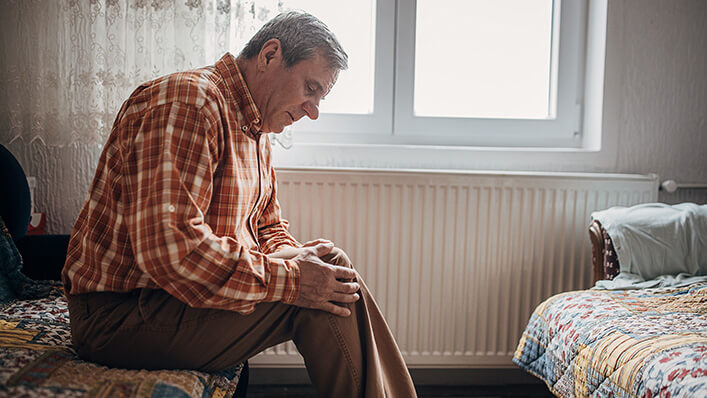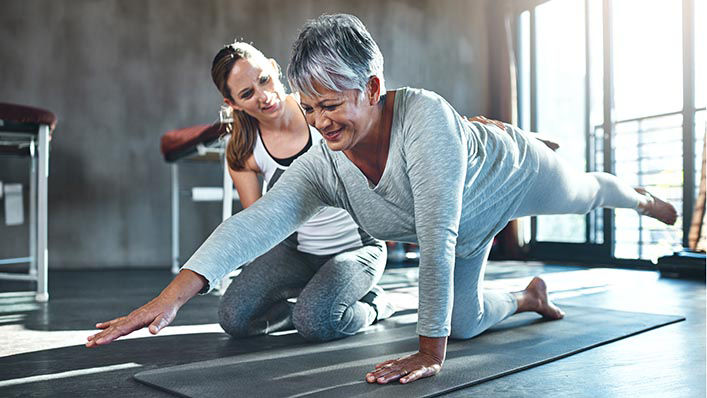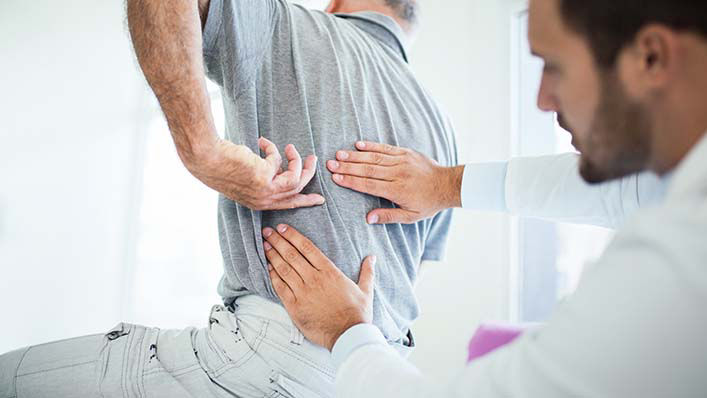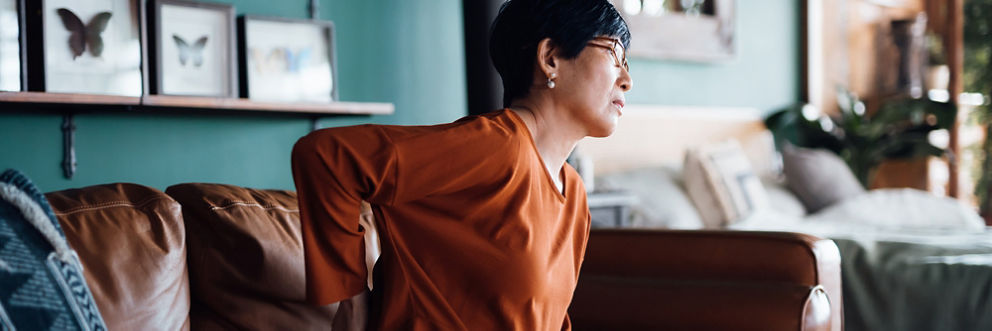Osteoarthritis
Osteoarthritis treatment for joint pain relief in Minnesota
Joint pain can seem like a natural part of aging. One day you might notice that your knees ache while walking down the stairs or that your hip hurts after a long day at work. These aches can range from annoying to debilitating.
If you have joint pain, you might have a condition called osteoarthritis. This is the most common type of arthritis. It affects many adults, especially if you’re over the age of 50. Our orthopedic doctors, orthopedic surgeons, physical therapists,
Joint pain doesn’t need to be a part of your life, make an appointment to take your first step toward feeling better.
What is osteoarthritis?
Osteoarthritis, sometimes called degenerative joint disease (DJD) or wear-and-tear arthritis, is a condition when the articular cartilage in your joints breaks down. Articular cartilage is a type of connective tissue in your body. When it’s healthy, it’s smooth and provides cushioning to the joint. When it breaks down, it can cause pain, swelling and stiffness.
Osteoarthritis can occur at any age but is most common in people over 50 years old. And while it’s possible to get osteoarthritis in any joint, it often affects the hips, knees, shoulders and wrists.
Symptoms of osteoarthritis
- Loss of flexibility in the joint (limited range of motion)
- Joint aches or pains at the end of the day
- Joint pain during physical activity
- Joint instability or giving way
- Weak muscles around the joint
- Swelling around the joint
- Clicking or popping noises while moving your joint
- The feeling of bones rubbing together while moving (grating sensation)
- Bone spurs (hard bumps of bone around the affected joint)
- Noticeable changes in the alignment of the joint (deformity of the joint)
- Joint pain or stiffness after waking up in the morning or resting
Causes of osteoarthritis
Osteoarthritis may have several underlying causes. One of the most common is wear and tear as we age. When we get older, we can lose or damage the cartilage in our joints, causing pain and stiffness.
Traumatic injuries can also cause osteoarthritis. Inflammation in your joints after an injury may cause the articular cartilage to break down. Heavy, prolonged use of the joints, like regularly lifting heavy objects, can also cause osteoarthritis.
A history of joint infection or gout can also increase your risk of developing osteoarthritis.
Tests we use to diagnose osteoarthritis
Diagnosing osteoarthritis starts with an appointment with your provider. During the appointment, we’ll talk with you about your symptoms and take a look at the affected joints. In most cases, we’ll need to perform tests to diagnose osteoarthritis and rule out other conditions. Common tests we use to diagnose osteoarthritis include joint aspiration and imaging tests like X-rays, ultrasounds and MRIs.
Imaging tests
Osteoarthritis can cause changes to the joints that are visible on imaging tests like X-rays, ultrasounds and MRIs. We’ll use imaging to check for the narrowing of the space between bones, bone spurs, changes to the cartilage in your joint, fluid buildup and other symptoms of osteoarthritis.

Four stages of osteoarthritis
Osteoarthritis is typically a progressive condition, meaning that it can get worse over time. Depending on your symptoms, osteoarthritis can be divided into four different stages:
Stage 1 – Minor
This is the first stage of osteoarthritis where the pain is minor. You may start to notice some joint pain and stiffness, but it should be easy to manage minor joint pain with over-the-counter medicines.
Stage 2 – Mild
During the mild stage, the cartilage in your joints starts to break down. This can cause more discomfort than during stage one. You might start to notice pain while doing daily activities, like a twinge in your knee or hip while getting in and out of the car.
When osteoarthritis is mild,
Stage 3 – Moderate
Your osteoarthritis symptoms will be moderate during stage three. You may notice pain and stiffness limit your range of movement and ability to do physical activities. You may have to modify your favorite exercises or take the stairs a bit more slowly. Joint swelling is also common during this stage of osteoarthritis, and existing bone spurs may be noticeable while new bone spurs may develop.
When osteoarthritis is moderate, we’ll talk with you about different treatment options. Physical therapy can still be effective, but we may recommend combining it with joint injections or other treatments. Depending on your condition, we may also begin to talk about
Stage 4 – Advanced
This is the most severe stage of osteoarthritis. During stage four, there will be little to no cartilage between the bones.
Most people experience a lot of pain, stiffness and swelling when osteoarthritis is advanced. This will make it very difficult to do daily tasks and physical activities – you may have trouble walking up and down stairs, or even tying your shoes. If your condition becomes advanced, osteoarthritis surgery may be the best course of treatment to manage the condition.
Treatments for osteoarthritis
It’s probably time to speak to a doctor about your osteoarthritis symptoms if they’re making it hard to get through everyday activities. If osteoarthritis is left untreated, it can become increasingly difficult to get through your day-to-day life, and you may notice more severe joint stiffness and a loss of mobility.
We’ll work with you to develop a personalized treatment plan that may include some of these common treatments:
Osteoarthritis medications
There are many medicines that can help manage joint pain and swelling. We commonly recommend nonsteroidal anti-inflammatory drugs (NSAIDs) to help reduce inflammation and swelling in and around the joint. These include over-the-counter options like aspirin, ibuprofen (Advil) and naproxen sodium (Aleve).
If NSAIDs don’t help relieve joint pain, we may prescribe other types of medicines depending on your specific condition.
Injections for osteoarthritis
Your joints are surrounded by fluid. This fluid helps lubricate the joints and acts as a shock absorber.
We can use injections of artificial joint fluid (hyaluronic) to help lubricate your joints, relieving pain and stiffness, and returning them to normal function.
Cortisone injections are also commonly used to manage osteoarthritis pain. Cortisone is a steroid that can help reduce painful inflammation and swelling around the joint.
Injection treatments can provide longer-term relief from osteoarthritis symptoms than medicines, but they are not permanent solutions. We often prescribe them in addition to other treatments, like physical therapy.
Physical therapy for osteoarthritis
Our board-certified physical therapists will create a personalized treatment plan to target the muscles around your joints. We’ll also teach you how to modify your favorite activities to help you move comfortably throughout the day and get back to the things you love.
Regenerative medicine for osteoarthritis
Regenerative medicine is a type of medicine that uses the latest medical technologies to help heal damaged tissue and reduce pain. Our cartilage regenerative program helps treat cartilage damage by replacing damaged tissue in the affected joints. This is a leading-edge treatment that we’re proud to offer to our patients.
There are three approaches we use to restore some of the cartilage that has been damaged by wear and tear. The first is microfracture treatment. This is done to stimulate repair tissue in your cartilage. This can help heal some of the damaged tissue and reduce pain.
Another approach is using cell-based technology to regrow some of your tissue. To do this, we’ll take some healthy cells from your body, let them multiply in our lab, and implant them into the damaged joint. This can be more effective than microfracture treatment.
The third approach we use is transplanting healthy cartilage and bone into the affected joint (osteochondral allograft). The healthy bone and cartilage may come from your own body or a donor. By replacing damaged tissue with healthy tissue, you’ll feel less pain and be able to move more confidently.
We typically recommend this treatment for younger patients in order to reduce pain, improve function and slow the progression of osteoarthritis.
Orthobiologics
TRIA is at the forefront of orthobiologics and is a leader in the research, education and use of this new treatment option.
Orthobiologic treatments are often used alongside other treatments like medications or physical therapy, as an alternative to surgery.
Osteoarthritis surgery
In most cases, we can manage osteoarthritis symptoms with nonsurgical treatments. We’ll only guide you toward surgery if it’s the best treatment option for you. If we do recommend surgery as the best course of treatment, we’ll explain the procedure and answer all of your questions.
We may recommend joint replacement surgery to treat osteoarthritis.
Osteotomy
Osteotomy is a type of surgery where we realign how the bones fit together to improve movement. The goal of an osteotomy is to shift the weight so a less-involved part of the joint bears your weight. This helps reduce pain and improve your mobility. Osteotomies are typically performed on knees, though we sometimes recommend osteotomies for ankles and hips.
Joint replacement surgery
Specialty programs for osteoarthritis

Fall Prevention and Balance Program
Osteoarthritis makes you 2.5 times more likely to experience a fall or injury. During this program, our orthopedic experts will help improve your strength and balance through exercise and training.

Aquatic Therapy Program
Exercising in the water reduces the pressure on your joints while helping you improve your strength, stamina and flexibility. Our program is led by board-certified physical therapists who use the latest technology.

Pain Management Program
Everyone experiences pain differently. Our Pain Management Program creates individual plans to reduce your pain with therapy, medicine and other treatments so you can comfortably get through the day.
